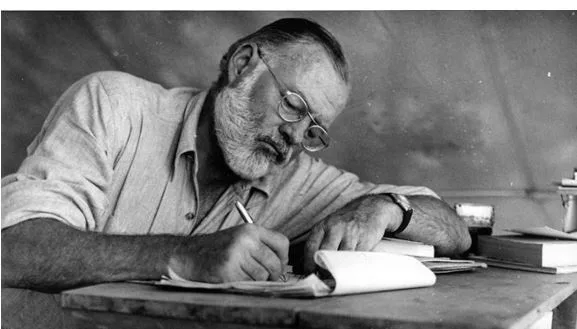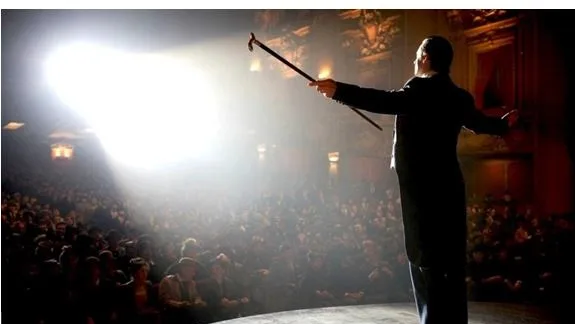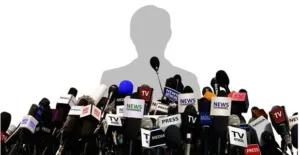
Now you’re looking for the secret. But you won’t find it because, of course, you’re not really looking. You don’t really want to work it out. You want to be fooled.
Cutter, The Prestige, Touchstone Productions, 2006
With everyone trying to figure out what the M&E industry will look like in the years ahead, this year’s NAB should be the most exciting, most chaotic event in the show’s 100 years.
After our recent break, the show schedule is packed with industry game-changing sessions, discussions, and opportunities for exhibitors and their management to show they will play an important part in the ever-changing content development, production/distribution, and delivery industry.
It will be important, perhaps even crucial, because:
- It’s the place where firms of every size launch new product concepts, new products.
- It’s the show that brings together the best potential business partners from around the globe.
- It’s the event that everyone interested in news, entertainment, and content production/monetization must cover.
It will be an even more difficult event because:
- Every new firm, every small to midsize organization must compete for attention side-by-side with the biggest names in the industry.
- There’s a backlog of technological advances people want to see firsthand, up close, and personally.
- There are so many changes, opportunities, roadblocks, and potential dead ends emerging that defining a position in the industry is difficult.
- Publicists will do anything to get their hands on media folks to explain why their firms are important, vital even.
Regardless of the chaos, NAB this year will be the place where reputations—company and individual—are made or broken, live or die. As in the past, large companies will have big events, big parties. Smaller firms usually can’t financially justify tightly choreographed events, so they often settle for crumbs.
However, no company has to “go big or go home.” Instead, they will have to think differently, think more creatively, and do it all exceptionally well. The key is to leverage everything you do to maximize your return on investment (ROI), while minimizing wasted time, money, and, most of all, opportunities.
Doing show media activities on the cheap only proves that as far as your organization is concerned, it’s an expense, not an investment. It’s the road to no positive results! NAB PR should be part of your total program, not a one-shot deal. That means NAB communications should have its own set of goals, strategies, tactics, and defined/measurable results. It requires a professional plan, professional materials, professional approach, professional budget. Anything less is a waste of time, effort, money, opportunity, and, worst of all, a disservice to management and the press.
Professionals will usually tell you that you should have made your biggest, best announcements a month or two before the show, rather than compete with the major announcements and unforeseen “news” incidents. That’s when industry’s new product, service, and activity coverage is light. You’ll have a better chance of getting more positive and in-depth coverage.
In addition, you’ll have a better opportunity to attract decision-makers to your booth, rather than hoping they’ll stumble in during the show and say “OMG!”
Of course, it’s tough to convince your boss because:
- Management knows they have to keep their best under wraps until the show and then surprise the competition.
- The major trade show becomes an engineering/development deadline for project completion, even though they have been coasting along for months.
Jeez!!!
Products are only one of the details for effective NAB activities, not the plan itself. The challenge for every company, every announcement is that you’re competing with everyone else at the show for mindshare. Getting coverage before the show means people—customers, prospects, partners, the media—will be able to plan a visit to the booth at the show, so the event and investment will be more profitable. It’s a tough sell to management, but that doesn’t mean they don’t deserve your best recommendations. So, get over it!
Focus on doing the best you can for the company, management, marketing, the products, the media, the audience. One of those activities is a paperless pressroom. NAB management has long been an advocate of the paperless pressroom. But it has been something many publicists still find difficult to relinquish. Publicists give lip service to the online world but still put their press materials on USB flash drives for members of the media; or worse, have a bunch of press kits in the booth, just in case. It’s estimated that 99% of that effort is wasted!

Editors/reporters usually say the USB drives or kits are accepted but never used because:
- The drive only identifies the company, seldom the event and date. There is no indication of the company news entrapped on the drive.
- If the editor/reporter is going to get information to use at the show, he or she has to load the drive, read through the content, determine if there are product/story ideas they want to cover on the floor, and remember to follow up. It doesn’t happen!Their schedules are too tight to do your work for you.
- If the kit is on a flash drive, we’ve seen guys/gals grab a handful… well, because.
Every media person has a drawer full of drives in his/her desk that they erase and use for important things. Or they give the devices to friends or family to use. Oh yeah, there’s another big problem with these physically stored releases: The newest, best announcements aren’t finalized until days or hours before the show. You know it… we know it!
Eliminate the Stress, the Hassle
PR Newswire has worked closely with trade events for years and has pioneered the online pressroom. The online pressroom makes it fast and easy for media people at the show and around the globe to register and receive company announcements. Some firms take a different approach, putting their press materials on their press website. That’s OK, but it’s also like having a self-standing store somewhere, rather than being in a large shopping mall.
If you’re looking for a new pair of shoes, it’s a lot easier to walk the mall—or better yet, go online—rather than driving from store to store.
For the average publicist—and his/her boss—the PR Newswire NAB pressroom is sufficient:
- The basic press kit is cheap and provides plenty of room for the show announcements, photos, and white papers.
- Releases go live (are available for viewing) on the day/hour you specify.
- Your information is not only available to the media at NAB, but also to registered media around the globe who want to cover the show but can’t afford the expense of the trip to Las Vegas.
- The kit is available online six months after the show for people to visit/review, but you’ll quickly find that interest fades to almost zero four to six weeks after the show.
- A detailed analysis of press kit and press release access is provided post-show, so PR and management can see exactly which announcements were most interesting to people, which announcements were not only visited but opened, what areas of the country/globe viewed the kit/announcements, and specifically who the individual was and his/her media outlet.
More to do
But for the person who wants to/needs to do a great NAB PR job, there’s more that can be done.
It just takes a little creative thinking to develop a special online package for your company/products.
Want to attract post-NAB coverage from the media? Include the link to the show news on a special business card as a gentle reminder of your news. NAB coverage doesn’t begin with the mad rush onto the floor on the opening morning of the show.
Distribute special invites and news teasers/major announcements in advance of the show so you can interest them in visiting the stand. You know, something more than—are you attending, are you interested in talking with X, how about stopping by?

It’s a good way to get the attention of attending media. And, it is a great way to press the flesh, exchange cards, give them an idea what you’re highlighting this year, and set up a firm in-stand meeting. Of course, for most publicists, it’s probably the only time they’ll talk to the media during the year. The rest of the time, you don’t call… you don’t write… you don’t even send flowers. We know… too busy with all your social media stuff. But, the show is where the boss expects you to deliver… in spades! That’s when PR pros go beyond the standard online kit.
Develop your own package that meets your objectives:
- Determine which releases are most critical for the company and have PR Newswire schedule them for release over the wire.
- Convince management that the best results will be achieved with a schedule of announcements, not everything going live the first day of the show. Then, schedule outreach to the media signed up for the show a month and a couple of weeks prior to the show.
- Use the preshow, daily summaries going to the media people, and make your announcements on specific days.
- Take advantage of the preshow publications by providing them with news, information, interviews well in advance of NAB (and we do mean well in advance).
- Think in terms of really educating, informing, exciting, and assistingthe people who access your online press kit with white papers, PowerPoint presentations, and embedded videos.
- Pinpoint the direct access location of your press kit well before the show, and publish the link in your media contact information; and, for God’s sake, don’t use the sterile standard press@ XYZ… use real people’s names!
- Print special cards that give summaries of your announcements along with the press kit link, and give them to media people at Show Stoppers, in the booth. A little trick we learned over the years is to put the show information on one side and note-taking lines on the other side. They’ll take notes and hang onto the card to use when they get back to their hotel room or office.
These are the easy parts of the show effort… all they require are thinking and planning ahead. The hard part is writing the news.

Good writing is damn hard work.
Author unknown
It’s called “news” for a reason. It’s about new products, new services, and new applications. It’s about establishing the company’s position, focus, and direction. It is not about including copies of releases from the past three months. It is not about stuffing the online kit with data sheets and brochures. It is about quality news, not quantity.
Releases aren’t short stories or the great American novel. Releases should:
- Begin with contact names, phone numbers, and email addresses. For NAB, let the press know where you’re staying and your cell phone number. If they need something—information, quote, photo sent somewhere—they need information immediately, not when it is convenient for you.
- Be written with the editor/reporter in mind and his/her audience—not management’s.
- Start with the essentials—who, what, when, where, why, and how.
- Be written in a manner that permits the editor/reporter to go easily from the summary idea to the greatest detail.
- Be well formatted so they are inviting and easy to read, with bold-faced subheads, so they can be quickly scanned and the reporter quickly gets the essence of the news.
- Include information essential to the story and the editor/reporter, not management-flattering “fluff.”
- Be simple, factual, complete. Tell the complete story, deliver all the facts… and stop.
- Be written to position the company and product/service quickly, clearly, and concisely.
- Have complete sentences with active nouns and verbs.
- Follow the fundamental news style and have solid/complete information—nothing more, nothing less.
- Include contact information at the end on how the press can get more information, photos, and request a review product, if appropriate.
If the story is complex or needs amplification, include a good PowerPoint presentation or video in the kit. Or include a clear, concise, and complete white paper or backgrounder. Just remember, good information doesn’t sell itself. There are 1,000-plus companies from around the globe clamoring to get the most media coverage they can by the nearly 800-plus outlets attending as well as many more that could not afford to send people.
They’re hungry for the news and information now!

Remember what Cutter said, “You’re a magician, not a wizard.” Sure, you could be, but then you’d have to talk with them, work with them, assist them year-round.

